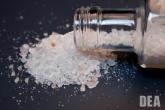One of the main chemicals in synthetic stimulants sold as "bath salts" or "plant food" is now a Schedule I drug, the Drug Enforcement Administration has announced.
The ruling permanently places methylone (3,4-methylenedioxy-N-methylcathinone) in the most restrictive category created by the Controlled Substance Act; Schedule I is reserved for unsafe and highly abused substances with no accepted medical use.
The agency first put methylone on emergency scheduling in 2011 while studying whether the chemical should be permanently controlled. In a related effort, the agency also issued a Notice of Intent to temporarily control three synthetic cannabinoids (UR-144, XLR11, and AKB48) that are falsely marketed as "herbal incense."
"This action will become effective upon publishing a Final Order to temporarily control these substances as Schedule I substances for up to 2 years, with the possibility of a 1-year extension," according to a DEA news release.
Designer drugs like bath salts have become a public health concern in recent years. The substances are popular among some young adults and teens, especially since they are obtained easily in certain stores and hookah bars.
Officials first became aware of the new intoxicants when poison control centers began receiving calls from emergency departments and physicians who could not identify the substance affecting their paranoid, and sometimes violent, patients.
The effects of bath salts are similar to those of cocaine, LSD, and methamphetamine – increased heart rate and blood pressure, as well as hallucinations. Users also can experience extreme paranoia and violent behavior leading to self-harm or harm of others, according to the Office of National Drug Policy Control (ONDCP).
When it comes to synthetic marijuana, the effects include agitation, extreme nervousness, nausea, vomiting, tachycardia, elevated blood pressure, tremors and seizures, hallucinations, and dilated pupils, according to ONDCP.
Although there’s no antidote to these designer drugs, physicians recommend screening for them. The long-term effects of the drugs are not known but are potentially severe. Use of these drugs has led to dozens of deaths.
In 2010, poison control centers received 2,906 calls relating to human exposure to synthetic marijuana, according to the American Association of Poison Control Centers. That number more than doubled to 6,959 in 2011 but then dropped to 2,655 in 2012, partly due to the emergency ban that the DEA put on the substances in late 2011. As of the end of this March, there had been 254 calls to poison control centers.
nmiller@frontlinemedcom.com
On Twitter @NaseemSMiller
